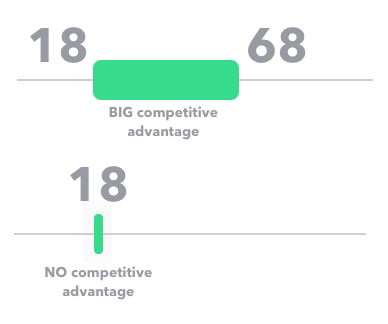Content Inventory Analysis: 3 Decision-Making Metrics
This post looks at how three MarketMuse metrics can help make better decisions when conducting a content inventory analysis. If you’re faced with lots of things to write about or pages to update, but find it a challenge to prioritize, then read on. You’ll learn how these metrics can be used to further refine your list of potential candidates, decide what to prioritize and whether you should even pull the trigger.
Best of all, you’ll have a content strategy that has demonstrable value with the confidence that it will succeed.
Unrealized Value
This metric helps decide whether a content opportunity is worth pursuing. In other words, is there enough upside to spending time improving a content asset? It’s determined by subtracting the Current Value from the Potential Value.
It’s based on an estimation of the traffic and its value. In MarketMuse, you can define the value of a visit, but I prefer to stick with the default, which is cost-per-click (CPC). In our case, CPC is a good representation of value, since bottom-of-the-funnel terms (high-intent) are more expensive than broader terms at the top.

Like all other metrics, it can be filtered, and sorted. In this example, the list has been sorted by Unrealized Value in descending order, so that the most valuable topics appear at the top. Other metrics have been used to filter the list of over 5,000 topics. There are still 647 topics remaining in the list, so I may want to add Unrealized Value as a filter to create a more manageable short list.
Personalized Difficulty
Now that I know whether a content opportunity is worth my time, I want to know how much effort is required. Not that I’m lazy. It’s just that there’s a big difference in effort between updating a page versus creating a whole cluster.
That’s where Personalized Difficulty shines.
As its name suggests, Personalized Difficulty is personalized to your site: it’s contents, and its performance. While others have made strides in improving their Keyword Difficulty, in the end it’s still a generalized metric that applies to everyone, regardless of their site.
But Personalized Difficulty is all about you.
Personalized Difficulty is based on Topical Authority and there’s an inverse relationship between the two. The higher your Topic Authority the lower your Personalized Difficulty.
Low is good when it comes to Personalized Difficulty. Your topical authority will make it easier for you to do well in Search.
The best way to look at Personalized Difficulty is in terms of the ranges or bands.
- Below 20 — optimize the existing page (assuming the topic matches what the page is about). Otherwise create a new page.
- 20 to 35 — optimize the page as above and create/optimize a page or two of supporting content.
- 35 to 50 — optimize the page as above and build out/optimize your existing cluster.
- 50 plus — most likely you don’t have a cluster so you’ll need to build out this foundation.
Those ranges give you a reasonable expectation of what’s required to achieve success. Plus, it adds perspective to the Unrealized Value metric. For example, pursuing a high unrealized value opportunity may not be in your best interest if it requires a significant investment in content.
Just like Unrealized Value, consider using this metric as a filter to refine your list of candidates even further.
Competitive Advantage
So far, we’ve used these metrics to identify high-value opportunities that are easy to execute. Which is great, in theory. Now the question is how likely am I to achieve a positive outcome?
Sure, it may be worth my while and not require a lot of effort to execute. But I still want everything to be stacked in my favor. That’s where Competitive Advantage comes into play. This MarketMuse metric expresses the difference between Difficulty (which applies to everyone) and Personalized Difficulty (which applies to your site).

If you have a strong Competitive Advantage, then you are likely to succeed. So this metric works very well as a probability indicator. When there’s no Competitive Advantage, you’re just as likely as anyone to find success.
But when you have a strong Competitive advantage, you’re working from a position of strength. And that’s always an enviable position to be in. When using this metric, look for large green bars that are skewed to the left. That gives you the easiest opportunities that are likely to come to fruition.
Although Competitive Advantage is expressed as a Japanese candlestick, you can filter or sort by this metric numerically.
The Perfect Trifecta
Combining all three metrics gives you a content plan with a defined value in dollars: the amount of effort involved, and the likelihood of success. Finally, you can tackle content opportunities confidently, with a reasonable expectation of success.
What you should do now
When you’re ready… here are 3 ways we can help you publish better content, faster:
- Book time with MarketMuse Schedule a live demo with one of our strategists to see how MarketMuse can help your team reach their content goals.
- If you’d like to learn how to create better content faster, visit our blog. It’s full of resources to help scale content.
- If you know another marketer who’d enjoy reading this page, share it with them via email, LinkedIn, Twitter, or Facebook.
Stephen leads the content strategy blog for MarketMuse, an AI-powered Content Intelligence and Strategy Platform. You can connect with him on social or his personal blog.